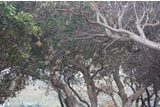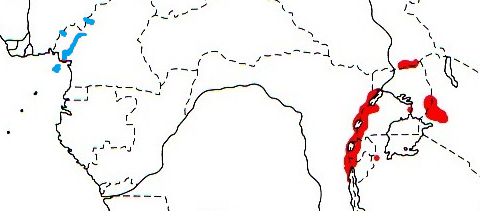Weaver species
Choose different species from drop-down list and press 'Go' button. See Full species list.Black-billed Weaver Ploceus melanogaster
IUCN: Least concern Discovery: 083Categories: fruit, frogs, Ploceus 6: 'Hyphanturgus',
News items about species
Discovery
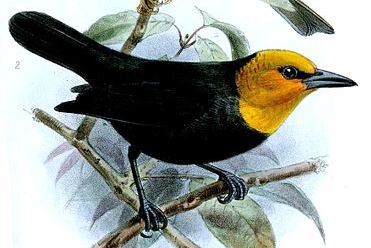
figure from Shelley (1887) 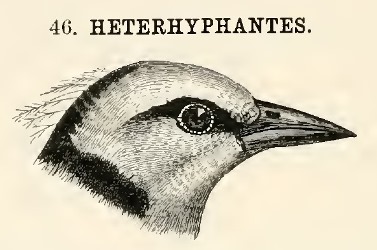
figure from Sharpe (1890) 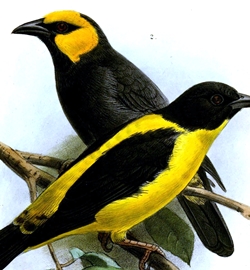
figure from Sharpe (1891) 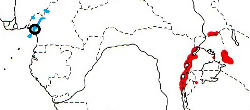
distribution, type locality circled IntroductionThe Black-billed Weaver was formally described by George Ernest Shelley, an English geologist and ornithologist.The Black-billed Weaver was collected by Harry Johnston, a British explorer, botanist, and colonial administrator. Johnston climbed Mount Cameroon to collect explore and specimens. Burton and others had preceeded him, but Johnston found some new mammals and birds. He experienced a week of rain at 7350 feet (2.2 km) and then transferred his camp to Hunter's Hut at 8300 feet (2.5 km), in "a narrow peninsula of forest which pushes up the mountainside". Here he collected a female of the Black-billed Weaver, which Johnston thought was a male (the male was first collected a few years later). Johnston reached the summit of Mount Cameroon at 4km elevation, being the the fourth most prominent peak in Africa. Shortly after this expedition, in October 1886, the British government appointed him vice-consul in Cameroon and the Niger River delta area. The first illustration of the Black-billed Weaver was published by Shelley (1887) when he described the species. The next illustration to be published was a line drawing of the head published by Sharpe (1890), also of a female. Sharpe (1891) first illustrated a male. Scientific citationPloceus melanogaster Shelley 1887, Proc. Zool. Soc. London, p.126, Cameroon Mt., 8000 ft.Meaning of namesmelanogaster, Greek: melas, black; gaster, the belly.First English nameJohnston's Yellow-headed Black Weaver (Shelley 1905).Alternate namesBlack Mountain Weaver, Jackson's Yellow-headed Black Weaver, Johnston's Yellow-headed Black Weaver, Uganda Black-billed Weaver, Yellow-faced Black Weaver.CollectorHarry Johnston.Date collectedSep 1886.Locality collectedMt Cameroon.Type specimensThe type is in the British Museum (BM 1887.3.7.34). |
The above is based on Weaver Wednesday 2, a weekly series about the discovery of each weaver species.
This species text first appeared as
Weaver Wednesday [200] - Discovery [83]: Black-billed Weaver on 2016-04-13
1. Basic biology
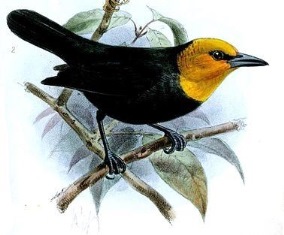
figure from Shelley 1887 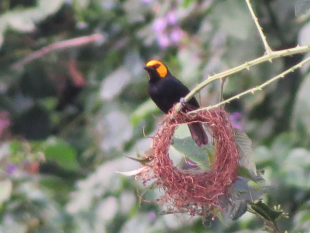
figure from PHOWN Identification. The Black-billed Weaver is a striking black bird with some yellow on the head and is found in forest undergrowth. The yellow varies according to subspecies and sex: the yellow extends to the throat in the female but the male's throat is black; the male of the nominate race has a yellow collar across the breast. Young birds are variable depending on their age, with dark brown upperparts, and brown to olive or buff below, but they are always identifiable by a yellowish face patch. This is one of 3 spectacled weavers (see also Spectacled Weaver), with a black line running from the bill through the eye. The all-black Vieillot's Black Weaver P. nigerrimus overlaps in range but occurs mainly in the canopy.
Distribution.
The Black-billed Weaver is found in 2 widely separated populations which form 2 subspecies (see map below, based on Birds of Africa):
Habitat.
The Black-billed Weaver inhabits undergrowth and dense secondary bush at 540-2440 m (mainly 1000-2200 m) in montane forest. There is one record in a Eucalyptus plantation. There may be seasonal altitudinal movements. It generally keeps low in dense foliage, and sometimes comes to the ground, where it moves by hopping. It is usually found in pairs, but at times 5-6 birds may be together. The Black-billed Weaver sometimes joins mixed-species flocks.
Food. Its diet is insects, including ants, beetles, termite alates, cicadas and caterpillars. It also feeds on fruits and seeds and once on a small frog. The Black-billed Weaver hangs upside down to probe curled leaves, and gathers in numbers to feed on fruit. Breeding. The Black-billed Weaver is a solitary, monogamous nester. The nest is retort-shaped, with or without a tunnel below. There is a ledge inside the nest to prevent eggs from falling out. The nest is strongly woven from tough, dry grass stems, and is lined with finer material such as black fibres. It is suspended from the end of a branch, long thin tendril, or tree-fern frond. The nest is sited 3-6 m above the ground or forest stream, and easily visible. The clutch is 2, and the eggs are white, with very fine, regular, pinkish brown spotting. The female incubates the eggs and both parents feed insects to the young. Old nests of the Black-billed Weaver may be used by Dusky-blue Flycatchers Muscicapa comitata and rarely by Shelley's Oliveback Nesocharis shelleyi. |
The above is based on Weaver Wednesday, a weekly series about weaver species.
This species text first appeared as
Weaver Wednesday [60]: Black-billed Weaver on 2013-08-07
2. Breeding facts
| Pair bond Monogamous Breeding season Dec in Nigeria, Oct-Jan (mainly Dec) in Cameroon, Jan on Bioko I, Nov-Mar and Aug in Sudan, Dec-Jan, Oct-Nov and May-Jun in Uganda; Jan-Apr, Jun and Sept in Kenya, Jan-Apr and Sept in DRCongo, and Nov in Rwanda Nest site suspended 3-6 m above ground (sometimes over a stream) from tip of branch, tendril of creeper or tree-fern frond, and easily visible Nest building no information Colony size Solitary nester Clutch size 2 eggs Egg colour white with very fine, evenly scattered pinkish-brown spots Egg size 21 x 15 mm (Sudan) Incubation incubation by female only, no information on duration of incubation period Chicks and nestling period chicks brooded and fed by both sexes, no information on duration of nestling period |
Breeding information based on Handbook of the Birds of the World, Vol. 15.
3. Photos of Weaver Nests
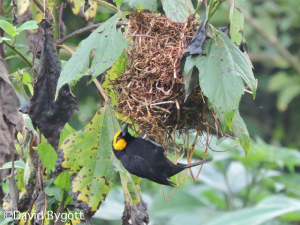 Vm 18666 | 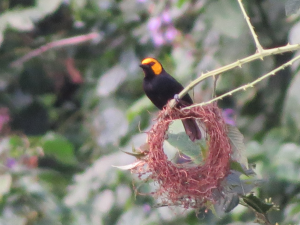 Vm 17608 | 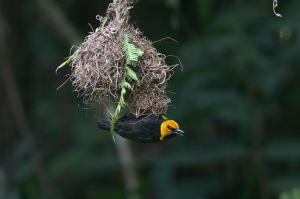 Vm 13808 |  Vm 6901 |  Vm 2474 |
Thumb-nails of most recent PHOWN records - click on one to see its full record
See all PHOWN records for this species here.
PHOWN (Photos of Weaver Nests) provides valuable info on breeding distribution and colony sizes of weavers.
You can contribute by registering and submitting photos at Virtual Museum webpage.
4. Breeding distribution
Google map showing distribution (For species with small ranges you need to zoom in at the correct area to see the range):
yellow blob - range of weaver species; read more about this here.
![]() - PHOWN records with photos
- PHOWN records with photos
![]() - PHOWN records with no photos (Nest Record Cards, other records)
- PHOWN records with no photos (Nest Record Cards, other records)
![]() - Birdpix records
- Birdpix records
![]() - comments on out of range records, or interesting records
- comments on out of range records, or interesting records
![]() - type locality
- type locality
CLICK on the marker on the map to see individual record details.
5. Range changes
Not South African speciesThe above is based on Weaver Wednesday 3, a weekly series about range changes in South African weaver species.
This species text first appeared as
n/a








